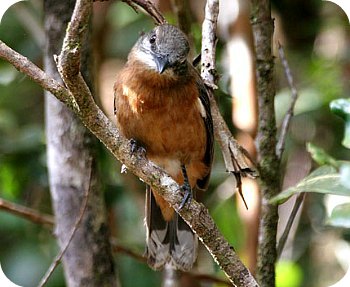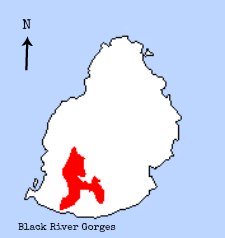Mauritius Cuckooshrike
Coracina typica
Factsheet
The Mauritius Cuckooshrike is a small endemic arboreal passerine and lives mostly on the canopy of the upland forests of Mauritius.
Due to its small range and population, the species is classified Vulnerable on the IUCN Red List. Habitat loss and exotic mammalian predators are the main reasons behind the decrease in its population size.
To a lesser extent, the spraying of organochlorine pesticide (DDT) in the 1950s and 1960s to control malaria also caused a rarefaction of the birds.
Conservation efforts to rehabilitate native ecosystems are well under way and there are evidences that the cuckooshrike is responding positively to this environment.
Any substantial increase in the range and population size of the species may eventually lead to its status being downlisted to Near Threatened by the IUCN.

Photo Courtesy: C. Moores
(A female cuckooshrike)
Common name:
English: Mauritius Cuckooshrike
French: Echenilleur de l'Ile Maurice, Merle Cuisinier
Mauritian Creole: merle kuzinye
Species name author:
Gustav Hartlaub, a German ornithologist (1865)
Taxonomy:
Order: Passeriformes
Family: Campephagidae (Cuckoo-shrikes)
Current IUCN Red List category:
Vulnerable and may eventually be downlisted to Near Threatened (NT)

International Union for the Conservation of Nature - Vulnerable (VU)
Description:
Male: upperparts are grey, with white underparts
Female: upperparts are brownish with rufous underparts
Size - about 22 cm
Average mass - 40 g
Population:
Size: 600-700 mature individuals
Trend - stable
Distribution size (breeding/resident): 120 sq km
Habitat:
Medium forest dependency
Inhabits the canopy of the tropical forests of Black River Gorges, Bel Ombre, Combo and Macchabée as well as adjacent areas of degraded forests.
Conservationists' anecdotal evidences support that its distribution within forest are linked to food availability.
Diet:
Mantids, stick insects, spiders and geckos
Threats:
Habitat loss and degradation caused by the introduction of exotic plants and poor regeneration of native plants.
Feral cats and introduced mammalian predators such as rats, monkeys and mongoose.
To a lesser extent, the destruction of nests, eggs and chicks by tropical cyclones.
Conservation:
The species is responding well to rehabilitation of native ecosystems in Conservation Management Areas, which has included exclusion of introduced animals and replacement of exotic plants with native species.
Distribution Map

Other Endangered Bird Species of Mauritius
■ Mauritius Kestrel ■ Mauritius Olive White-eye ■ Pink Pigeon, ■ Mauritius Echo Parakeet ■ Mascarene Paradise Flycatcher ■ Mauritius Black Bulbul ■ Mauritius Grey White Eye ■ Mauritius Fody
Return from Mauritius Cuckooshrike to Mauritius Holidays Discovery Home